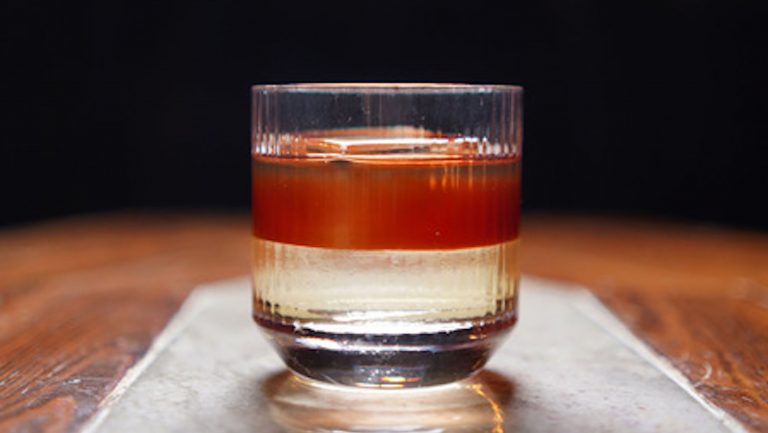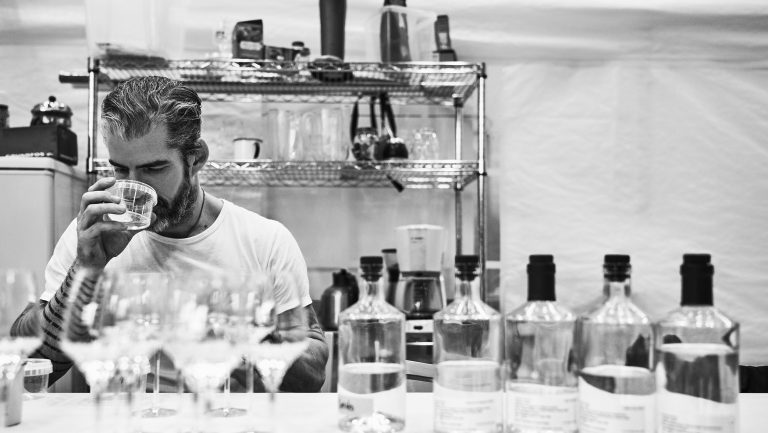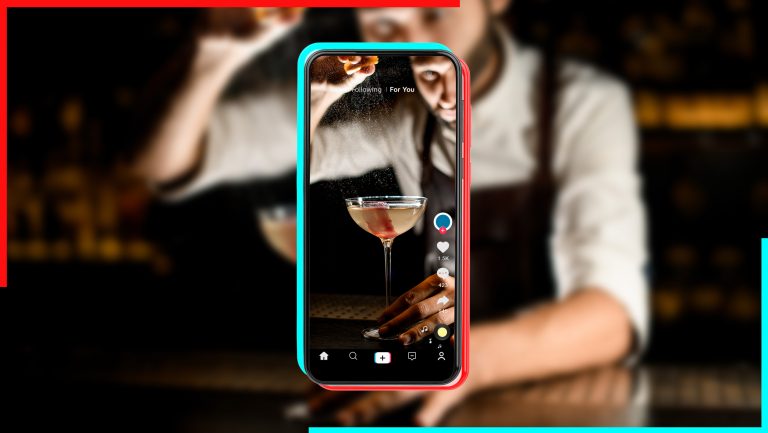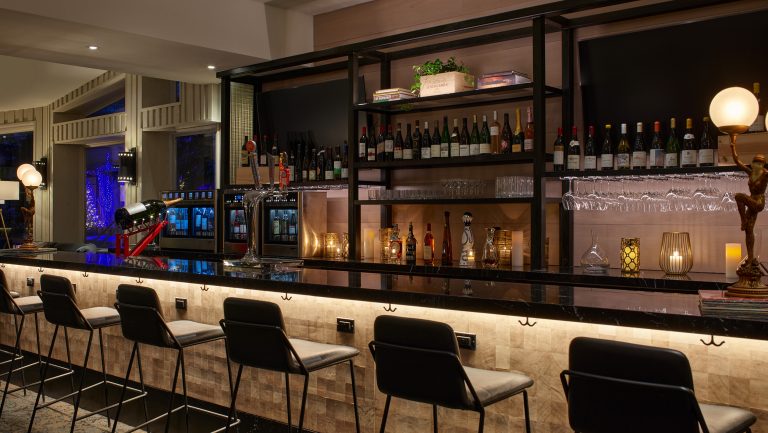The role of cocktail bartenders, much like sommeliers, is multifaceted: helping connect consumers with a beverage they’ll enjoy, but also encouraging them to expand their palates, introducing new flavors and concepts, and championing emerging brands or spirit categories. “All of our bartenders look at every single customer, see what they’re ordering, and has in their mind two to three cocktails that they know that person would like,” and may be able to steer them toward, says Laura Unterberg, the beverage director of The Fox Bar and Cocktail Club in Nashville, Tennessee.
While the self-selecting audience that seeks out creative, craft cocktail bars likely have a sense of adventure where spirits are concerned, this isn’t always a given when it comes to cocktails that lead with a new or unfamiliar spirit. “They want to be wowed, but they can be afraid of what they don’t already know,” says Khalid Williams, the founder of The Barrel Age, a Hartford, Connecticut-based bar consultant and brand advocate.
In a culture where vodka, tequila, and whiskey account for a majority of our alcohol consumption, using new or niche spirits as the leading ingredient in a cocktail can be a risk. This may include spirits from around the world that have a long history but are just beginning to gain traction in the U.S. market, such as baijiu, sotol, poitín, and arak, among many others, as well as those that are new or uncategorizable concepts altogether, as in Empirical’s sorghum-based Soka.

Don’t miss the latest drinks industry news and insights. Sign up for our award-winning newsletters and get insider intel, resources, and trends delivered to your inbox every week.
Bartenders are often on the front line when it comes to connecting consumers with these spirits, and play an important role in a spirit’s potential success. For Lars Williams, one of the founders of Empirical, the brand behind Soka, bartenders are vital to explaining Soka, an uncategorizable spirit, to a new audience. “When we actually can put liquid to lips, that becomes a moment where people kind of understand,” he says, and cocktails are one of the best ways to do that. “[It’s a matter of] just getting in front of bartenders who can help do the storytelling.”
Khalid Williams concurs: “We can be gatekeepers,” he says. “We can’t always make a brand, but we can definitely break one if we don’t believe in suggesting it.”
Among bars that routinely feature emerging spirits on their menus, there are many strategies for how bartenders can introduce these to consumers in a way that engenders not only willingness, but the ongoing sense of curiosity and discovery that keeps them returning.
Give Unfamiliar Spirits a Familiar Framework

The simplest way to put forth an unfamiliar spirit as the leading cocktail ingredient is to put it in a familiar or accessible package. “I don’t usually use a really unfamiliar spirit along with less familiar flavors,” says Unterberg, whose rotating list features nearly 30 cocktails. “I might put it in something that’s really crushable and accessible, make it brightly colored, or give it a fun, easy to pronounce name,” she says. The Half Human/Half Machine from The Fox Bar’s current list, for example, puts forward Glendalough Poitín as the leading spirit, and supports it with blueberry and maple.
Nate Dobson, the head bartender of New York City’s Banzarbar, also encourages openness among consumers by utilizing unfamiliar spirits in a split base approach, or giving them the classic cocktail treatment. “People will gloss over [the unfamiliar], even if it’s the predominant ingredient, when they see the words ‘Old Fashioned,’” they say. Importantly, it gives them an idea about what to expect.
Empower Staff Through Education
“You have to have what I call your ‘hand-sell army,’” says Khalid Williams. Vodka or whiskey-based cocktails may always be your best sellers and more frequently cold-called by patrons, but, “there will always be a population of staff that is motivated to talk to customers and get them excited about a particular spirit,” he says.
Education is key. “When we bring in new bottles, everybody from managers to barbacks are tasting it,” says Unterberg. “For new products, I do encourage my staff, when a guest asks ‘what’s this?’ to be able to pour a tiny taste to let people experience it on its own.” This can have financial implications, but Unterberg notes that having balance in the overall menu between staple, value-driven brands and emerging spirits is important to being able to feature these lesser-known products, and allow for sampling.
Furthermore, “having a good relationship with your distributors, and doing your own research is imperative,” she says, so that cost doesn’t become a prohibitive issue. “When our bartenders are pitching drinks for consideration, if it’s good, it goes on the menu,” she says. “If it’s a $14 cocktail, or if it’s a $24 cocktail, we’ll price it accordingly.”

The Importance of Storytelling
Dobson points out that for creative menus spieling various cocktails is already part of the expectation for both staff and guests. “Cocktails don’t always sell themselves,” they say, “so we’re regularly having to talk about the menu, which gives us an opportunity to explain certain unknown spirits.”
This can go beyond simple production information, historical context, or tasting notes. For Empirical’s Soka, for example, Dobson features it on Banzarbar’s list as a “sorghum distillate” cocktail called God’s Green Earth. When describing it, Dobson likens its flavor to agricole rhum, but it’s also an opportunity to educate consumers about the inclusion and importance of lesser-known spirits beyond flavor.
“I always make the argument about why I appreciate the work of Empirical specifically because we need less monocultures in how we’re consuming spirits,” they say, especially in light of overconsumption and sustainability issues related to common spirit crops such as agave and corn. “Even speaking through cocktails, you can make an argument for a bigger and better world.”
Unterberg’s menu also supports a similar ethos: “The Fox Bar is proudly a minimal waste concept, and offering products that are produced less industrially, and often from regions with few other exports, allows us to make cocktails that align with our environmental and social values.”
A Global Perspective
While spirits from around the world may be new to some U.S. consumers, in many cases the food or flavors from a given area may already be well known outside that cultural context. “Since Asian food is something we’re all fanatical about, leaning into those flavors is absolutely helpful in order to get started,” says Khalid Williams, speaking of incorporating Asian spirits such as baijiu, shochu, soju, or feni in a cocktail menu.

“That whole what-grows-together-goes-together mentality is great,” says Unterberg, who also emphasizes that this approach must be taken thoughtfully and appropriately. “The flipside of that is, conceptualizing and observing without appropriating,” she says, noting the importance of combining the flavors and culture of a specific spirit in a single drink, not just a litany of pan-Asian ingredients, and using sensitivity when it comes to naming the cocktail.
Whether you are looking to add a single cocktail to a menu that highlights an unfamiliar ingredient, or develop a cocktail menu that highlights several at once, doing so consistently can create a sense of trust and a space for consumers who specifically come back in search of the unfamiliar. You might not be able to create a trend or demand for a specific spirit, but a sense of newness and an ongoing curiosity can become the draw itself. “Our program is devoted to exploring distilled spirits on a global perspective,” says Dobson. “Part of the reason that guests come to us is because they want to try something new.”
When presented creatively and appropriately, this might also have influence beyond the realm of beverages. “It’s not only exciting to show people what’s new and unfamiliar,” says Unterberg, “it can make people more open globally. If a variety of spirits become more accessible and more mainstream, it has broader implications than just drinking culture—people become more accepting of a lot of different things from around the world, food and beverage included.”

Dispatch
Sign up for our award-winning newsletter
Don’t miss the latest drinks industry news and insights—delivered to your inbox every week.






